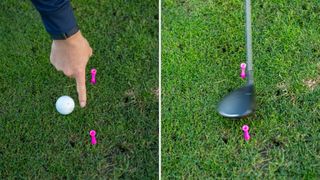3 Moves To Master Your Fairway Woods
Golf Monthly Top 50 Coach Alex Elliott shares three simple tips that will help you master your fairway woods


For golfers of all levels, fairway woods are usually the toughest to hit consistently well. So, in the video and article below, Golf Monthly Top 50 Coach Alex Elliott shares three tips that will help you turn this weakness into a strength.
Don't lean back
First, you need to understand why you are struggling with your fairway woods. One of the big reasons is the intimidation factor. At address, it doesn’t look like there’s a lot of loft on the club. That causes golfers to feel like they need to help the ball into the air, which causes them to lean back and scoop it.

Leaning back is a recipe for disaster with fairway woods
This analogy will help you gain an understanding of what’s required. Think of the bottom of the club as the wheels of a plane. Now, you don’t want to abort the landing as that results in the scooping motion. I don’t want you to crash land and swing too steeply into the ball. Instead, I want you to feel like you’re getting the wheels just to touch down as you’re striking the ball away.
Gate drill
The second drill will help you keep the club lower for longer and increase your margin for error and the quality of strike. Simply create a gate by sticking two tees into the ground an inch or so ahead of your ball. Once you’ve done that, knock your ball out the way and address the bit of ground where it was sitting. Feel like you’re going to brush the ground through the gate and not lean back to avoid the gate. Doing this successfully will help you keep the clubhead lower for longer and improve your consistency.

Use this gate drill to improve your fairway wood ball-striking
The reason I want you to move the ball out the way is because, as you do this, you’ll feel like you need to transfer your weight and open your hips to start training the feeling of keeping the clubhead lower for longer. Start with some hip-height swings back and through to hone the feeling. When you feel comfortable, bring the ball back in and put what you’ve worked on to the test. Add this drill to your practice routine and you’ll quickly stabilise your swing for better fairway wood strikes.
Stabilising your legs
The final concept is all about stabilising your legs for a solid foundation. If you’re swaying, the bottom of your arc is constantly moving, meaning it’s harder to marry up the low point of the swing with the golf ball. Put your hands on your belt, one on your lead hip and one on your trail hip, and practise just turning your hips back and through rather than swaying.

Turning with your lower half rather than swaying will help you control the bottom of the arc
Then, make some practice swings trying to feel that same turn in your lower half, imagining there’s a wall behind you that you want to press your back-right pocket into on the backswing, and the left-back pocket into in the through swing. It’s a simple concept that will help stabilise the bottom of your arc.
Get the Golf Monthly Newsletter
Subscribe to the Golf Monthly newsletter to stay up to date with all the latest tour news, equipment news, reviews, head-to-heads and buyer’s guides from our team of experienced experts.

Location: Mottram Hall
Alex spent a great deal of time learning the game from fellow northwest golfer, Andrew Murray, who was a European Tour regular from 1979 to 1995. He spent three years on the European Tour caddying for Andrew’s son, Tom, before taking his PGA qualifications. His passion for the game and personality in front of the camera has helped him to create a thriving social media platform on Instagram and YouTube, where he offers a whole host of tips and advice to help viewers shoot lower scores.
Most significant influences on your teaching:
Mike Bender's book, 'Build The Swing Of A Lifetime', which I read during my PGA qualifications. He uses so many different tools to help students deliver the club better when hitting the golf ball. Andrew Murray, too. He helped form the way I interact with golfers and simplified what can be a complex game for a club golfer.
Advice for practice:
I like to get students to work in sets of five golf balls – three drills shots to two course shots. The drill shots have no consequence, but with the two course shots, I ask the student to create a green or fairway and go through a full routine.
Greatest success story:
One of my students hadn’t played golf for ten years - he'd lost his love for the game. After watching my online Instagram and YouTube content, he came for several golf lessons and has now joined a local golf club. Knowing I've helped get someone back into golf... you can't beat that.
-
 Masters Runner-Up Ludvig Aberg Has Major Ambitions (And World No.1 Goal)
Masters Runner-Up Ludvig Aberg Has Major Ambitions (And World No.1 Goal)The Swede sensation is targeting Major glory after pushing World No.1 Scottie Scheffler all the way at Augusta
By Michael Weston Published
-
 TecTecTec Team8E Golf GPS Earbuds Review
TecTecTec Team8E Golf GPS Earbuds ReviewJoe Ferguson gets his first experience of golf-specific GPS wireless headphones…
By Joe Ferguson Published